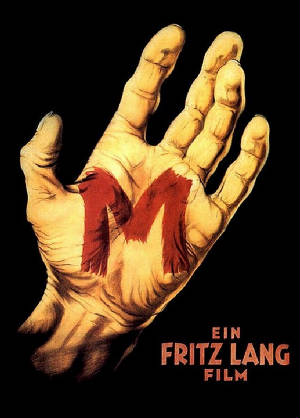|

(1931, directed by Fritz Lang)
- inducted 2013 -
"Whenever a non-cinephile friend declares that they don’t like 'old movies'—
which usually means those made before 1960, in black-and-white, although the year continually seems to be moving forward as
American culture increasingly fetishizes the 'new'— I tell them to watch Fritz Lang’s M, and they inevitably
return to me with a rave. I suspect that this is because, over 80 years since its initial German release in 1931, the film
still feels stylistically and socially relevant.
"Analyses of M usually position it one of the key German Expressionist films, which is certainly true, although doing
so has the unfortunate effect of minimizing the film’s individual contributions to cinema down the line, all the way
up to today. I choose to more generally view it as a foundational film in both the horror and crime genres—yet still
superior to most all its successors—and the foundational film in the ever-popular sub-genre that intertwines the two,
the serial killer procedural.
"Perhaps the film’s most significant contribution to Horror is the way Lang manipulates sound to ride the nerves of
the audience. M was Lang’s first talkie, but dialogue is not the most important part of it until the very end,
during Peter Lorre’s infamous monologue. Instead, the most striking sonic elements throughout are the recurrent whistle
of Lorre’s focal child killer, Hans Beckert—a spine-chilling rendition of Grieg’s 'In the Hall of the Mountain
King' that smartly factors into the plot later on—and sudden stretches of silence, the absence of sound proving to be
as vital an effect as the presence of sound.
"But M is only a horror film to the extent that it seeks to instill in the viewer the same sense of dread that the
city of Berlin feels with a loose killer roaming in its midst. Once instilled, M becomes more of a crime film, with
Lang pioneering the now-standard method of cross-cutting between cops and criminals. I say criminals, plural, because Beckert
isn’t the only one the film focuses on; underworld bosses also play a significant role in the story, as they organize
their own hunt for Beckert, tired of the police raiding their establishments looking for the fugitive.
"Through Beckert’s stranglehold over every part of the city—the cops, the criminal underground, and the public
at large—Lang develops much of M’s rich social commentary. The film is in part a mediation on how a society
can project all its problems onto a single individual (or, as would happen just a few years later in the Germany that Lang
fled, an ethnic group). Unlike the film’s stylistic achievements, it’s unfortunate that this facet of the film
is still relevant today—when the media, which only plays a small role in M, fosters such a societal tendency to no end—though
this relevance is what allows the film to retain all its power for modern audiences.
"Then there’s Lorre’s epic final speech — a triumph of acting and a harrowingly intimate exploration of
another important social issue, that of how a civilized society should handle people who do evil things. Individual viewers
will answer this question differently, based on their unique ideological perspective. The film takes a position of its own,
but Lang doesn’t lay it on thick. Instead, the brilliance of M’s concluding moments rests in the fact that,
in order to earn our position, we must confront the reality that despite his horrible crimes, Beckert is still a human being
— perhaps the most terrifying and complex element of a masterpiece that’s full of them."
~ Danny Baldwin
Principal cast: Peter Lorre, Ellen Widmann, Inge Landgut, Otto Wernicke, Theodor Loos, Gustaf Gründgens, Friedrich
Gnass, Fritz Odemar, Paul Kemp, Theo Lingen, Rudolf Bümmer, Georg John, Franz Stein, Ernst Stahl-Nachbaur, Gerhard Bienert,
Karl Platen, Rosa Valetti, Hertha von Walther
Screenplay by Thea von Harbou and Fritz Lang
Director of photography: Fritz Arno Wagner
Art direction by Emil Hasler
Film editing by Paul Falkenberg
Makeup by Wilhelm Weber
Sound by Adolf Jansen (sound), Paul Falkenberg (sound editor)
Set designer Edgar G. Ulmer (uncredited)
Based on an article by Egon Jacobson (uncredited)
Produced by Seymour Nebenzal (uncredited)
Germany
Duration: 117 minutes (original version)
Languages: German
Filmed in black and white
Sound mix: Mono
Aspect ratio: 1.20:1
Produced by Nero-Film AG
Released in USA by Foremco Pictures Corp.
Premiered in Berlin on 11 May 1931
USA release date: 31 March 1933
Awards and honors:
- Selected as one of Roger Ebert’s “Great Movies,” 3 August 1997
- National Board of Review: one of the Top Foreign films of 1933
|

